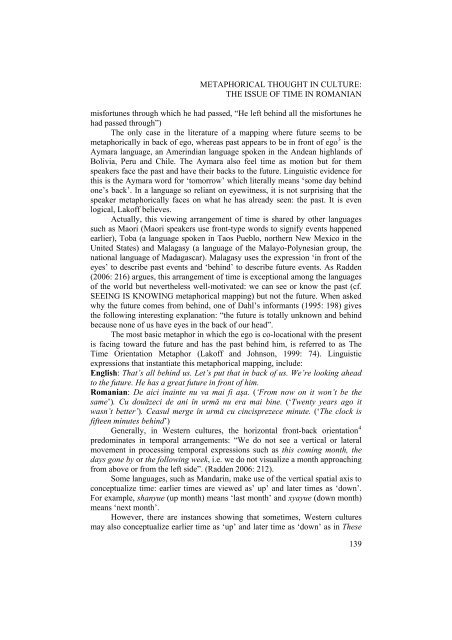culture, subculture and counterculture - Facultatea de Litere
culture, subculture and counterculture - Facultatea de Litere
culture, subculture and counterculture - Facultatea de Litere
Create successful ePaper yourself
Turn your PDF publications into a flip-book with our unique Google optimized e-Paper software.
METAPHORICAL THOUGHT IN CULTURE:<br />
THE ISSUE OF TIME IN ROMANIAN<br />
misfortunes through which he had passed, “He left behind all the misfortunes he<br />
had passed through”)<br />
The only case in the literature of a mapping where future seems to be<br />
metaphorically in back of ego, whereas past appears to be in front of ego 3 is the<br />
Aymara language, an Amerindian language spoken in the An<strong>de</strong>an highl<strong>and</strong>s of<br />
Bolivia, Peru <strong>and</strong> Chile. The Aymara also feel time as motion but for them<br />
speakers face the past <strong>and</strong> have their backs to the future. Linguistic evi<strong>de</strong>nce for<br />
this is the Aymara word for ‘tomorrow’ which literally means ‘some day behind<br />
one’s back’. In a language so reliant on eyewitness, it is not surprising that the<br />
speaker metaphorically faces on what he has already seen: the past. It is even<br />
logical, Lakoff believes.<br />
Actually, this viewing arrangement of time is shared by other languages<br />
such as Maori (Maori speakers use front-type words to signify events happened<br />
earlier), Toba (a language spoken in Taos Pueblo, northern New Mexico in the<br />
United States) <strong>and</strong> Malagasy (a language of the Malayo-Polynesian group, the<br />
national language of Madagascar). Malagasy uses the expression ‘in front of the<br />
eyes’ to <strong>de</strong>scribe past events <strong>and</strong> ‘behind’ to <strong>de</strong>scribe future events. As Rad<strong>de</strong>n<br />
(2006: 216) argues, this arrangement of time is exceptional among the languages<br />
of the world but nevertheless well-motivated: we can see or know the past (cf.<br />
SEEING IS KNOWING metaphorical mapping) but not the future. When asked<br />
why the future comes from behind, one of Dahl’s informants (1995: 198) gives<br />
the following interesting explanation: “the future is totally unknown <strong>and</strong> behind<br />
because none of us have eyes in the back of our head”.<br />
The most basic metaphor in which the ego is co-locational with the present<br />
is facing toward the future <strong>and</strong> has the past behind him, is referred to as The<br />
Time Orientation Metaphor (Lakoff <strong>and</strong> Johnson, 1999: 74). Linguistic<br />
expressions that instantiate this metaphorical mapping, inclu<strong>de</strong>:<br />
English: That’s all behind us. Let’s put that in back of us. We’re looking ahead<br />
to the future. He has a great future in front of him.<br />
Romanian: De aici înainte nu va mai fi aşa. (‘From now on it won’t be the<br />
same’). Cu douăzeci <strong>de</strong> ani în urmă nu era mai bine. (‘Twenty years ago it<br />
wasn’t better’). Ceasul merge în urmă cu cincisprezece minute. (‘The clock is<br />
fifteen minutes behind’)<br />
Generally, in Western <strong>culture</strong>s, the horizontal front-back orientation 4<br />
predominates in temporal arrangements: “We do not see a vertical or lateral<br />
movement in processing temporal expressions such as this coming month, the<br />
days gone by or the following week, i.e. we do not visualize a month approaching<br />
from above or from the left si<strong>de</strong>”. (Rad<strong>de</strong>n 2006: 212).<br />
Some languages, such as M<strong>and</strong>arin, make use of the vertical spatial axis to<br />
conceptualize time: earlier times are viewed as’ up’ <strong>and</strong> later times as ‘down’.<br />
For example, shanyue (up month) means ‘last month’ <strong>and</strong> xyayue (down month)<br />
means ‘next month’.<br />
However, there are instances showing that sometimes, Western <strong>culture</strong>s<br />
may also conceptualize earlier time as ‘up’ <strong>and</strong> later time as ‘down’ as in These<br />
139












